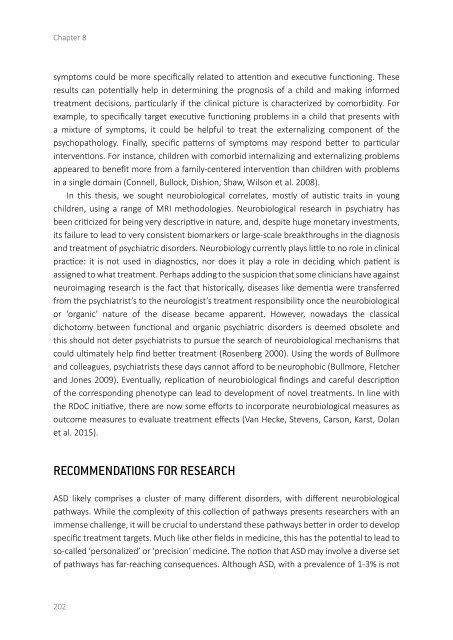On the Spectrum
2lm5UyR
2lm5UyR
Create successful ePaper yourself
Turn your PDF publications into a flip-book with our unique Google optimized e-Paper software.
Chapter 8<br />
symptoms could be more specifically related to attention and executive functioning. These<br />
results can potentially help in determining <strong>the</strong> prognosis of a child and making informed<br />
treatment decisions, particularly if <strong>the</strong> clinical picture is characterized by comorbidity. For<br />
example, to specifically target executive functioning problems in a child that presents with<br />
a mixture of symptoms, it could be helpful to treat <strong>the</strong> externalizing component of <strong>the</strong><br />
psychopathology. Finally, specific patterns of symptoms may respond better to particular<br />
interventions. For instance, children with comorbid internalizing and externalizing problems<br />
appeared to benefit more from a family-centered intervention than children with problems<br />
in a single domain (Connell, Bullock, Dishion, Shaw, Wilson et al. 2008).<br />
In this <strong>the</strong>sis, we sought neurobiological correlates, mostly of autistic traits in young<br />
children, using a range of MRI methodologies. Neurobiological research in psychiatry has<br />
been criticized for being very descriptive in nature, and, despite huge monetary investments,<br />
its failure to lead to very consistent biomarkers or large-scale breakthroughs in <strong>the</strong> diagnosis<br />
and treatment of psychiatric disorders. Neurobiology currently plays little to no role in clinical<br />
practice: it is not used in diagnostics, nor does it play a role in deciding which patient is<br />
assigned to what treatment. Perhaps adding to <strong>the</strong> suspicion that some clinicians have against<br />
neuroimaging research is <strong>the</strong> fact that historically, diseases like dementia were transferred<br />
from <strong>the</strong> psychiatrist’s to <strong>the</strong> neurologist’s treatment responsibility once <strong>the</strong> neurobiological<br />
or ‘organic’ nature of <strong>the</strong> disease became apparent. However, nowadays <strong>the</strong> classical<br />
dichotomy between functional and organic psychiatric disorders is deemed obsolete and<br />
this should not deter psychiatrists to pursue <strong>the</strong> search of neurobiological mechanisms that<br />
could ultimately help find better treatment (Rosenberg 2000). Using <strong>the</strong> words of Bullmore<br />
and colleagues, psychiatrists <strong>the</strong>se days cannot afford to be neurophobic (Bullmore, Fletcher<br />
and Jones 2009). Eventually, replication of neurobiological findings and careful description<br />
of <strong>the</strong> corresponding phenotype can lead to development of novel treatments. In line with<br />
<strong>the</strong> RDoC initiative, <strong>the</strong>re are now some efforts to incorporate neurobiological measures as<br />
outcome measures to evaluate treatment effects (Van Hecke, Stevens, Carson, Karst, Dolan<br />
et al. 2015).<br />
RECOMMENDATIONS FOR RESEARCH<br />
ASD likely comprises a cluster of many different disorders, with different neurobiological<br />
pathways. While <strong>the</strong> complexity of this collection of pathways presents researchers with an<br />
immense challenge, it will be crucial to understand <strong>the</strong>se pathways better in order to develop<br />
specific treatment targets. Much like o<strong>the</strong>r fields in medicine, this has <strong>the</strong> potential to lead to<br />
so-called ‘personalized’ or ‘precision’ medicine. The notion that ASD may involve a diverse set<br />
of pathways has far-reaching consequences. Although ASD, with a prevalence of 1-3% is not<br />
202


